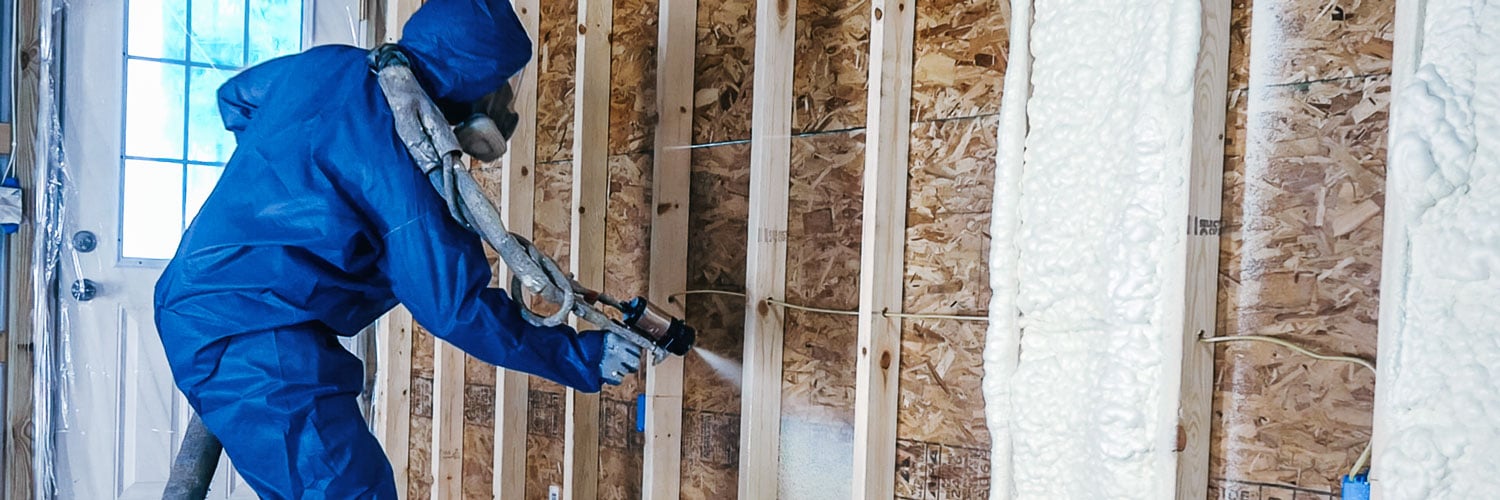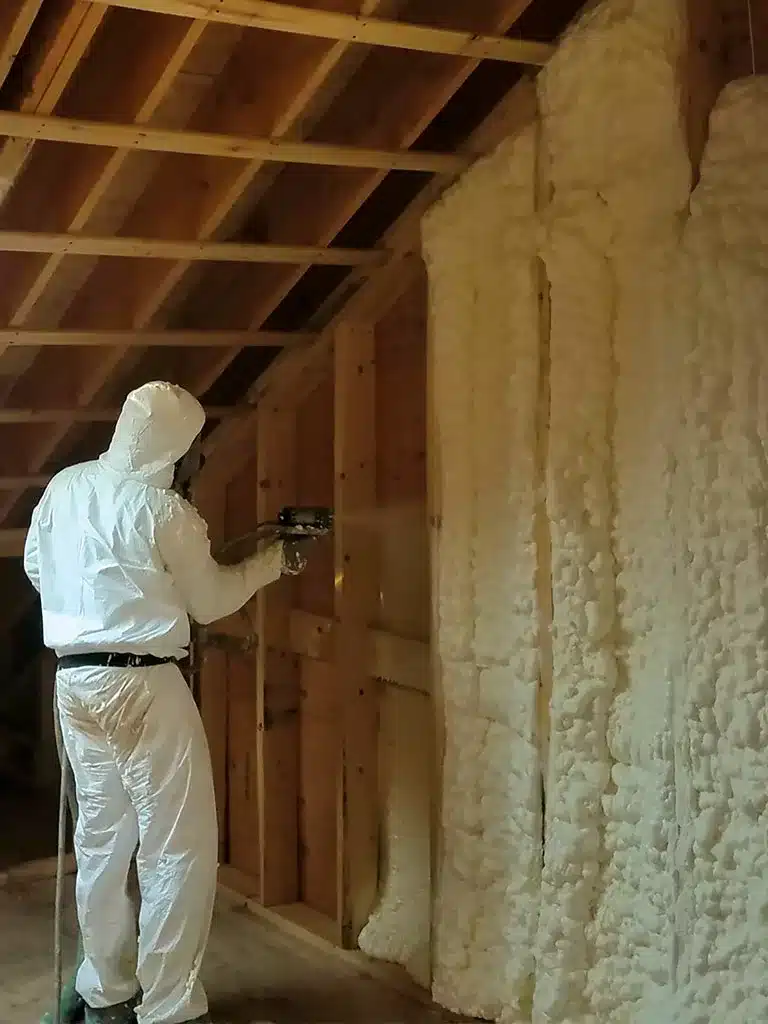Comprehending the Benefits of Using Spray Foam for Insulation Projects
Comprehending the Benefits of Using Spray Foam for Insulation Projects
Blog Article
Spray Foam: The Ultimate Service for Air Sealing and Insulation
Spray foam insulation has actually become a leading option for effective air sealing and thermal insulation, supplying a special combination of properties that set it in addition to conventional approaches. Its ability to expand and fill up voids makes it particularly efficient in protecting against air leakage, which can substantially influence energy effectiveness. Nonetheless, comprehending the complete scope of its benefits, setup procedures, and comparisons with other insulation kinds is essential for making educated decisions. As we check out these facets, the implications for both brand-new building and constructions and retrofits become progressively substantial. What factors should influence your option?
What Is Spray Foam?
Spray foam is a functional insulation material that combines the concepts of air securing and thermal resistance to enhance energy performance in buildings. Composed mostly of polyurethane or other comparable compounds, spray foam is used as a liquid that broadens upon call with surface areas, producing a strong, constant layer of insulation. This distinct residential property permits it to fill spaces, cracks, and gaps that standard insulation materials may ignore, supplying a superior air seal.
There are two main sorts of spray foam: open-cell and closed-cell. Open-cell spray foam is lighter and more flexible, providing exceptional noise absorption and a reduced R-value per inch - Spray Foam. On the other hand, closed-cell spray foam is denser, providing a higher R-value, wetness resistance, and included architectural stability to building elements
The application procedure generally includes customized tools, making certain a smooth application that sticks to different substrates, including wood, concrete, and steel. This versatility makes spray foam appropriate for both new building and constructions and retrofitting existing structures. Its ability to develop a closed barrier dramatically adds to minimizing power usage and enhancing indoor air top quality, thereby making it a recommended option among property owners and builders alike.
Benefits of Spray Foam Insulation
One of the most substantial advantages of spray foam insulation is its exceptional capacity to produce a continuous air barrier, which properly decreases energy loss. Unlike standard insulation products, spray foam expands to fill splits and gaps, guaranteeing that air leakage is substantially reduced. This characteristic not only improves energy performance but also results in reduce utility bills over time.
In addition, spray foam insulation supplies exceptional thermal resistance, adding to a more steady interior setting. Its high R-value per inch allows for reliable insulation in restricted spaces, making it suitable for attic rooms, wall surfaces, and crawl rooms. Moreover, the moisture-resistant properties of spray foam help stop mold and mildew and mold development, advertising much healthier living conditions.
One more important advantage of spray foam insulation is its sound-dampening top qualities (Spray Foam). It efficiently reduces noise transmission in between rooms, creating a quieter and more comfortable home environment. The sturdiness of spray foam also sticks out, as it does not droop or resolve with time, preserving its efficiency throughout its lifespan
Just How Spray Foam Functions
Recognizing how spray foam insulation works is crucial for appreciating its efficiency in air sealing and thermal resistance. Spray foam insulation consists of 2 key elements: isocyanate and polyol material. When these components are mixed, they undertake a chain reaction that triggers the material to expand rapidly, developing a thick foam that loads dental caries, spaces, and cracks.
As the foam expands, it sticks to surface areas, creating an airtight seal that significantly reduces air seepage. This particular makes spray Check Out Your URL foam insulation very effective at avoiding drafts and moisture infiltration, which can bring about power loss and damage with time. Furthermore, the closed-cell variant of spray foam uses exceptional thermal resistance because of its inflexible structure, properly decreasing heat transfer.
The special homes of spray foam enable it to adapt irregular surface areas, making certain extensive protection and a seamless barrier. Because of this, spray foam insulation not just improves power efficiency but likewise contributes to boosted interior air quality by decreasing the accumulation of irritants and contaminants. Inevitably, recognizing the technicians behind spray foam underscores its role as a superior option for insulation and air sealing in both domestic and industrial applications.
Installation Refine Summary

Before setup, the area needs to be appropriately cleaned up and prepped, guaranteeing that surfaces are without wetness, particles, and dirt. Because pollutants can jeopardize adhesion and overall performance, this action is important. Once the location is prepared, the application involves blending the two parts of the spray foam, which broadens upon contact and fills up spaces properly.
Trained professionals should conduct the installment, making use of customized tools to make sure uniform insurance coverage and ideal thickness. Safety preventative measures, consisting of putting on safety equipment and guaranteeing correct air flow, are essential during this process. After application, the foam commonly cures promptly, forming a solid barrier that boosts energy efficiency.
Contrasting Spray Foam to Typical Insulation
When examining insulation choices, spray foam insulation stands out in contrast to typical products such hop over to here as fiberglass and cellulose. Unlike fiberglass and cellulose, which can enable air seepage, spray foam broadens upon application, filling up crevices and gaps to develop an airtight seal.
In addition, spray foam gives a greater R-value per inch than traditional insulation kinds, providing even more reliable thermal resistance in a thinner account. This particular is particularly useful in areas with restricted dental caries deepness. Moreover, spray foam is resistant to moisture and mold growth, which can be a significant worry about cellulose and fiberglass, especially in moist environments.
However, spray foam insulation typically lugs a greater upfront price than its conventional equivalents. Homeowners have to weigh this initial investment against lasting power cost savings and performance benefits. Eventually, while both insulation kinds serve their objective, spray foam arises as a much more innovative service for modern insulation demands, specifically in regards to air securing and thermal effectiveness.

Final Thought
In recap, spray foam insulation stands for a very reliable service for accomplishing optimal air sealing and thermal resistance. Its special homes, including wetness resistance and noise dampening, make it appropriate for various applications in both brand-new buildings and retrofitting projects (Spray Foam). Although the initial prices may be higher compared to standard insulation materials, the long-term benefits, such as substantial energy savings and improved indoor air top quality, justify the investment and emphasize its worth in modern-day building techniques.
Spray foam insulation has actually emerged as a leading service for reliable air sealing and thermal insulation, supplying an one-of-a-kind mix of residential or commercial properties that set it apart from conventional techniques.Spray foam is a versatile insulation material that incorporates the principles of air sealing and thermal resistance to improve power effectiveness in structures.When evaluating insulation options, spray foam insulation stands out in comparison to typical products such as fiberglass and cellulose. Eventually, while both insulation kinds serve their objective, spray foam emerges as a more sophisticated solution for contemporary insulation requirements, particularly in terms of air securing and thermal efficiency.
In summary, spray foam insulation stands for a highly reliable remedy for attaining ideal air securing and thermal resistance.
Report this page